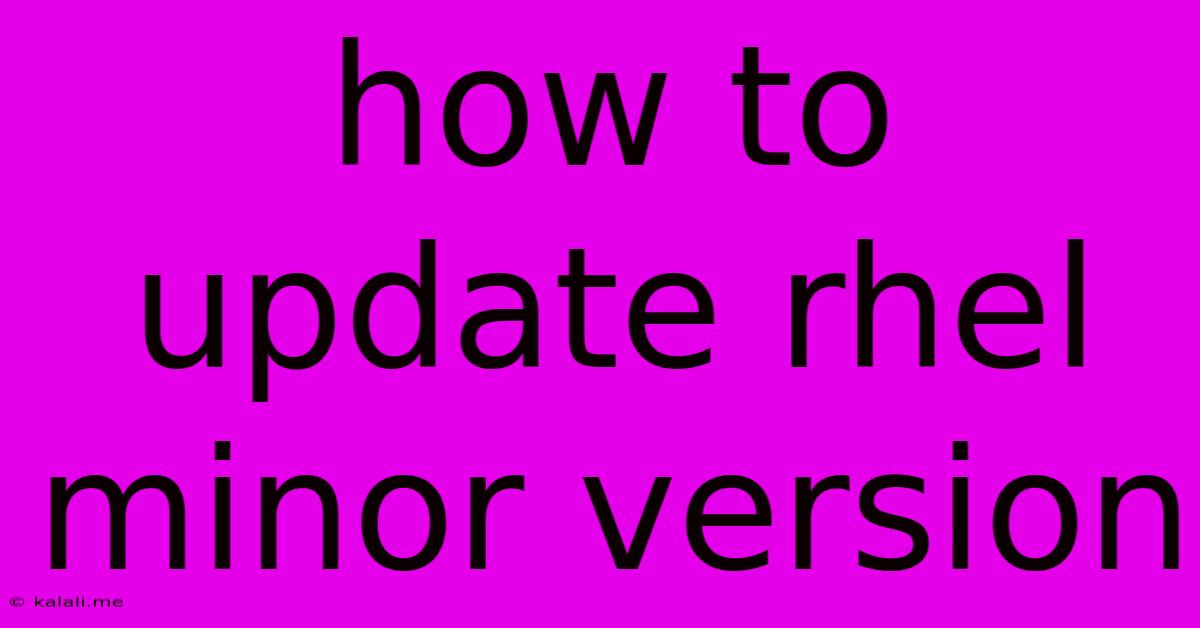How To Update Rhel Minor Version
Kalali
May 23, 2025 · 3 min read

Table of Contents
How to Update RHEL Minor Version: A Comprehensive Guide
This article provides a comprehensive guide on how to update your Red Hat Enterprise Linux (RHEL) system to a newer minor version. Updating to a minor version, such as from RHEL 8.4 to RHEL 8.5, allows you to benefit from the latest bug fixes, security patches, and performance improvements without undergoing a major version upgrade. This process involves using the subscription-manager tool and careful planning to ensure a smooth and successful update.
Understanding RHEL Versioning: Before diving into the update process, it's crucial to understand RHEL's versioning scheme. RHEL versions are structured as Major.Minor.Patch. Major versions (e.g., 7, 8, 9) represent significant changes and often require a more involved upgrade process. Minor versions (e.g., 8.4, 8.5, 8.6) are incremental releases focused on bug fixes, security updates, and new features. Patch releases (e.g., 8.4.1, 8.4.2) primarily address critical security vulnerabilities. This guide focuses on minor version updates.
Prerequisites for a Successful RHEL Minor Version Update:
- Active Subscription: Ensure your RHEL system has an active Red Hat subscription. This grants you access to the necessary update repositories.
- Sufficient Disk Space: Check for sufficient free disk space to accommodate the new packages. The update process may require significant temporary storage.
- Backup: Always back up your system data before starting any major update. This is crucial for data recovery in case anything goes wrong. Consider backing up your configuration files, databases, and other critical data.
- Network Connectivity: A stable and reliable network connection is essential throughout the update process.
- Root Privileges: You'll need root or sudo privileges to execute the necessary commands.
Steps to Update RHEL Minor Version:
-
Check Current Version: First, confirm your current RHEL version:
cat /etc/redhat-release -
Update the System: Before updating the minor version, make sure your system is fully updated with the latest patches for the current minor version:
sudo yum update -
Register the System (if needed): If your system isn't registered with Red Hat Subscription Manager, register it:
sudo subscription-manager register --username--password Replace
<your_username>and<your_password>with your Red Hat credentials. -
Attach the Appropriate Subscription: Ensure your system is subscribed to the correct repository for the target minor version. You can view your subscriptions using:
sudo subscription-manager listIf necessary, attach the appropriate subscription using:
sudo subscription-manager attach --pool=Replace
<pool_id>with the appropriate pool ID for your target minor version. -
Update to the New Minor Version: Use the
yumpackage manager to update to the new minor version. This command checks for available updates and prompts you for confirmation. (Remember to replace8.5with your target minor version):sudo yum update -
Reboot: After the update completes, reboot your system to ensure all changes take effect:
sudo reboot -
Verify the Update: After rebooting, verify the new RHEL version using the same command from step 1:
cat /etc/redhat-release
Troubleshooting Common Issues:
- Subscription Errors: Ensure your Red Hat subscription is active and correctly associated with your system. Check the Red Hat Customer Portal for details.
- Dependency Conflicts: Dependency conflicts can sometimes occur. If you encounter issues, consult the Red Hat documentation or support resources.
- Network Problems: Ensure you have a stable internet connection throughout the update process.
Important Considerations:
- Downtime: Plan for potential downtime during the update process, especially the reboot.
- Testing: Before updating production systems, it’s strongly recommended to test the update process on a staging or development environment first.
- High Availability: For systems with high availability requirements, follow Red Hat's recommended procedures for updating HA clusters.
By following these steps and carefully considering the prerequisites, you can successfully update your RHEL system to a newer minor version, keeping your infrastructure up-to-date and secure. Remember to always refer to the official Red Hat documentation for the most accurate and up-to-date instructions.
Latest Posts
Latest Posts
-
How Many Times Does 3 Go Into 30
Jul 13, 2025
-
In What Episode Of Bleach Does Ichigo Ask Orihime Out
Jul 13, 2025
-
How Much Is 4 Oz Chocolate Chips
Jul 13, 2025
-
How Many Times Does 9 Go Into 70
Jul 13, 2025
-
4 Pics 1 Word Cheat 8 Letters
Jul 13, 2025
Related Post
Thank you for visiting our website which covers about How To Update Rhel Minor Version . We hope the information provided has been useful to you. Feel free to contact us if you have any questions or need further assistance. See you next time and don't miss to bookmark.